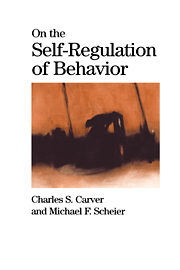Book contents
- Frontmatter
- Contents
- Preface
- Acknowledgments
- 1 Introduction and Plan
- 2 Principles of Feedback Control
- 3 Discrepancy-Reducing Feedback Processes in Behavior
- 4 Discrepancy-Enlarging Loops, and Three Further Issues
- 5 Goals and Behavior
- 6 Goals, Hierarchicality, and Behavior: Further Issues
- 7 Public and Private Aspects of the Self
- 8 Control Processes and Affect
- 9 Affect: Issues and Comparisons
- 10 Expectancies and Disengagement
- 11 Disengagement: Issues and Comparisons
- 12 Applications to Problems in Living
- 13 Hierarchicality and Problems in Living
- 14 Chaos and Dynamic Systems
- 15 Catastrophe Theory
- 16 Further Applications to Problems in Living
- 17 Is Behavior Controlled or Does It Emerge?
- 18 Goal Engagement, Life, and Death
- References
- Name Index
- Subject Index
15 - Catastrophe Theory
Published online by Cambridge University Press: 05 June 2012
- Frontmatter
- Contents
- Preface
- Acknowledgments
- 1 Introduction and Plan
- 2 Principles of Feedback Control
- 3 Discrepancy-Reducing Feedback Processes in Behavior
- 4 Discrepancy-Enlarging Loops, and Three Further Issues
- 5 Goals and Behavior
- 6 Goals, Hierarchicality, and Behavior: Further Issues
- 7 Public and Private Aspects of the Self
- 8 Control Processes and Affect
- 9 Affect: Issues and Comparisons
- 10 Expectancies and Disengagement
- 11 Disengagement: Issues and Comparisons
- 12 Applications to Problems in Living
- 13 Hierarchicality and Problems in Living
- 14 Chaos and Dynamic Systems
- 15 Catastrophe Theory
- 16 Further Applications to Problems in Living
- 17 Is Behavior Controlled or Does It Emerge?
- 18 Goal Engagement, Life, and Death
- References
- Name Index
- Subject Index
Summary
Catastrophe theory is a topological model focusing on creation of discontinuities, bifurcations, or splittings (Brown, 1995; Saunders, 1980; Stewart & Peregoy, 1983; Thorn, 1975; van der Maas & Molenaar, 1992; Woodcock & Davis, 1978; Zeeman, 1976,1977). A catastrophe occurs when a small change in one variable produces an abrupt (and usually large) change in another variable. The fact that the change is abrupt implies nonlinearity or discontinuity.
Despite having quite different origins and purposes, catastrophe theory shares several themes with dynamic systems theory. This focus on nonlinearity is one. You can easily think of the discontinuity that's the focus of catastrophe theory as reflecting two attractors. Phrased in the terms of attractors, a catastrophe in a surface represents “the sudden disappearance of one attractor and its basin, combined with the dominant emergence of another attractor” (Brown, 1995, p. 51). This isn't the only link between these sets of ideas. Indeed, a secondary theme of this chapter is the several parallels between dynamic systems theory and catastrophe theory (though some view the two as quite different - see Kelso, 1995, chap. 2).
THE CUSP CATASTROPHE
Several types of catastrophe exist (Brown, 1995; Saunders, 1980; Woodcock & Davis, 1978), each resulting from the operation of a specific number of control parameters. As we noted in Chapter 14, control parameters are variables that change the dynamics of a system's behavior. A figure portraying a catastrophe has one dimension corresponding to each control parameter, and another showing the “behavior” of the system in response to changes in control parameters.
- Type
- Chapter
- Information
- On the Self-Regulation of Behavior , pp. 275 - 295Publisher: Cambridge University PressPrint publication year: 1998



